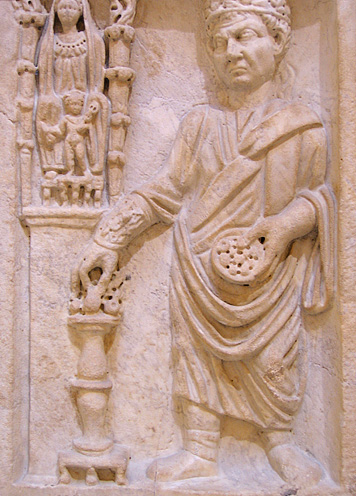Archigallus
The priesthood of the Archigallus is variously described as either being instituted sometime during the Imperial reign of Claudius (41-54 CE) or Antoninus Pius (137-161 CE). The Archigallus was always a Roman citizen chosen by the Quindecemviri Sacris Faciundis, whose term of service lasted for life [1] .
As a Roman citizen, as well as being employed by the Roman State, meant that the Archigallus must adhere to the laws and regulations of Roman Cult behavior. Hence, the Archigallus was never a eunuch, as all citizens of Rome were forbidden from emasculation. [2] . The signs of his office have been described as a type of crown, possibly a laurel wreath, as well as a golden bracelet known as the occabus [3] .
Along with the institution of the Archigallus came the Phrygianum sanctuary as well as the rite of the Taurobolium as it pertains to the Magna Mater, two aspects of the Magna Mater’s cultus that the Archigallus held dominion over [4] . The Phrygianum was built on Mons Vaticanus, where today sits St. Peter’s Basilica of the Vatican City. It was here at this sanctuary where the Archigallus would perform the rite of the Taurobolium for the citizens of Rome, as well as be consecrated as the Summus Sacerdos or High Priest.
The Archigallus was understood to be capable of prophecy and for this reason we know that it was understood that the Taurobolium was only performed by the sanctioning of the Magna Mater Herself, of which the Archigallus served as Her voice for Rome. The Archigallus is reported to have had dreams, presumably via incubation rites, as well as interpret the dreams of others who sought him out in regards to whether or not the Taurobolium should be conducted for a particular individual [5] . It was under the sole authority of the Archigallus that the Taurobolium could be performed, not even the Emperor himself could call for its execution [6] .
Other than the Taurobolium, the Archigallus participated in all rites concerning the Magna Mater that dealt with the Roman State. It was through the Archigallus and His rites that the Magna Mater’s blessings of health and well-being were conferred on the Emperor, the Imperial family, the Senate, the army and the Roman State and people as a whole [7] .
References
- ↑ See Adkins & Adkins, Dictionary of Roman Religion, p. 91.
- ↑ See Turcan, Cults of the Roman Empire, p. 49.
- ↑ See Turcan, Cults of the Roman Empire, p. 51.
- ↑ See Turcan, Cults of the Roman Empire, p. 51.
- ↑ See Borgeaud, Mother of the Gods, p. 111.
- ↑ See Turcan, Cults of the Roman Empire, p. 52.
- ↑ See Turcan, Cults of the Roman Empire, p. 52.
